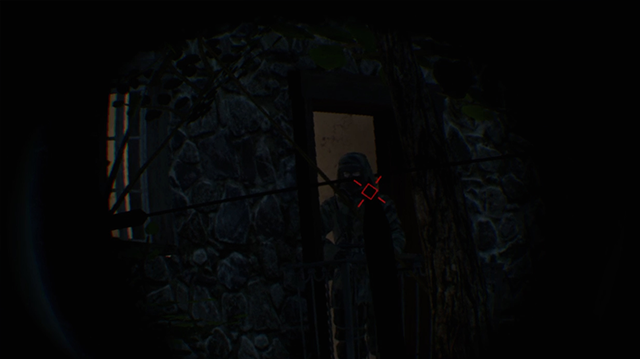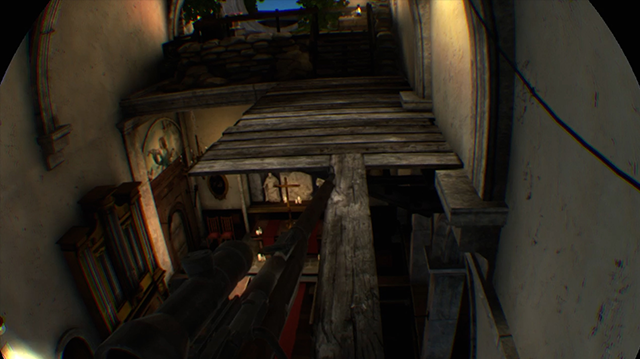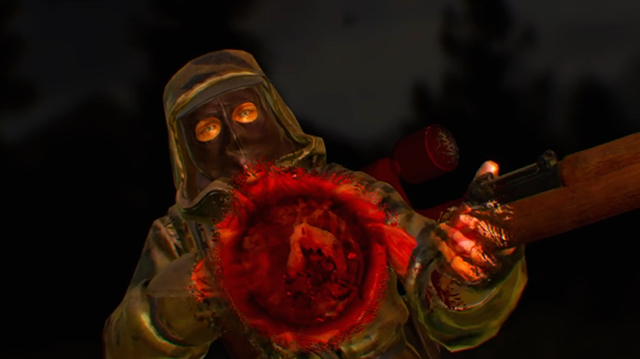I am deep in German-held territory. My target is a Nazi general. “One bullet can change the course of the war,” the narrator says.
The general departs a ship and drives in my direction. His rate is steady. Do I take the shot? No, I wait. He stops at a guard post. Now? Not yet. The general is walking closer and closer to the church tower I am hiding in. He asks his escort to stay behind, while he relieves himself in an alley.
This is my chance. He’s so close, and almost completely still. I take aim, place my finger on the trigger and… immediately start drifting hard to the right.
I re-center my VR tracker, and now I can’t aim low enough. Now too far left. Now right. As I struggle with the controls, the general calmly walks away and disappears. Mission failed.
Welcome to Snipe Elite VR.
Sniper Elite VR Review: Missed Shot

The Sniper Elite series has been a mainstay of the military shooter genre since 2005. The series is known for its combination of stealth and long-range shooting, with an iconic kill-cam that will sometimes zoom in and show the damage bullets done to bones and organs in gruesome detail.
Sniper Elite VR is the latest entry in the series, and it’s the first step into virtual reality. Players put on their favorite VR rig (this review was done on PSVR connected to a PS4 Pro) and step into the eyes and shoes of a World War 2 sniper as he recounts his personal story in the war. The game takes place across 18 missions, spread across war-torn Europe.
There are several control options. Movement can be smooth and untethered, similar to a modern FPS, or you can elect for the standard VR, teleport-from-point-to-point system, which is especially helpful for those that may be prone to motion sickness. Aside from the PlayStation Move controllers, you can opt to use a DualShock 4, as well. I played with both and preferred the DualShock, but both options work about the same.
The levels themselves are linear and a mixture of holding points to eliminate enemies and moving forward to complete various objectives. In general, the levels are fairly short. Tolerance for spending time in VR varies from person to person, so that was probably a wise design decision.
The sniping mechanic is interesting. The controller acts as a stand-in for your weapons. You raise it up to your face to aim down sights, and you can press a button on the controller to focus your shot. The scope is surprisingly authentic. Misaligning your eye with your scope creates a scope shadow, large black areas where you can’t see anything. I was pleasantly surprised to see this incorporated in the game.

The game is presented through the recollections of an old man, a partisan who fought in the war many years previous. He sits in his peaceful home, watching his family enjoy life, while he recounts his journey.
The narration continues during missions, and the well-acted voiceover provides a really nice atmosphere. The juxtaposition between the tranquil home setting and the grisly violence of war is poignant, and it adds weight to both sides of that equation.
Weapons, locations, and equipment are all WWII-authentic. It is one thing to mow down a squad of Nazis with a trench gun. It is quite another to pick one up and inspect it, turning it over in your hands to see details. Looking down at your belt to see ammo pouches and grenades, or watching the shell ejected from your shotgun roll across the floor, further serve to put you into the moment.
The problem is actually playing the game.
Movement works well enough, but the small arenas and tight corridors seem like something plucked out of the era of the original PlayStation. Shooting varies from competent to downright awful, which, in a game all about sniping, is a terrible thing to get wrong. It is so common to go from picking off enemy after enemy to suddenly having your rifle take on a mind of its own, and refuse to point in a certain direction.
I found myself frequently re-centering my screen, which breaks any hope of immersion, and fighting the controls at the most critical moments.
The stealth system is almost unusable. There are no melee attacks, so even if you sneak up behind someone your only option is to shoot them. The pistol works as well as the sniper, which is to say much, but not all of the time. Enemies have gauges that fill when they are becoming aware of your presence. They respond to gunfire and bodies but appear to have the memory of goldfish. If an enemy stumbles upon a body they will be concerned, then quickly go about the rest of their days.

Many levels use the classic sniper trope of “a very loud noise that happens at regular intervals” to give you a chance to shoot undetected. That’s fun for the first few levels, as you time your shots to airplanes or anti-air fire, but it is badly overused as a stealth mechanic.
There is no in-game autosave system, either. Most levels have radios that function as checkpoints, yet it’s another archaic system from a bygone era. These are often spaced too far apart, too, making gameplay frustrating at times.
Why? Because it doesn’t take many hits to kill you in this game. That would be fine, except the enemies are all crack shots. It is incredibly frustrating to be fighting with your gun controls, only to have a Nazi goon kill you with a pistol, sending you to a painfully long load screen, and forcing you to repeat entire sections of a level.
Outside of the occasional exploding red barrel, there is little to no interactivity with the environment. Levels are lifeless. Going through a narrow corridor in the woods feels the same as going through a narrow corridor in a Nazi base, which feels the same as going through the corridor of an Italian city. Levels have collectibles to find, but they don’t add to the experience meaningfully.
The visuals are nothing to write home about. PSVR is pretty limited hardware at this point, so the low resolution and general lack of texture in this version is not surprising. Authentic uniforms and settings devolve into various shades of brown, which become nearly indistinguishable from other objects at a distance. Still, that doesn’t detract much from the experience, and seeing even low-resolution explosions up close in VR can be thrilling.
There are some really good elements in this game, where the presentation is immersive, and the gameplay works, but these stretches never last. Far too often the poor shooting mechanics make the uninteresting levels a chore. By the end of the game, I found myself intentionally revealing my presence to enemies, then waiting around a corner to mow them all down with impunity. Anything to get to the end of the level.
Sniper Elite VR — The Bottom Line

Pros
- Compelling presentation, narrating the story
- X-ray kill-cam is gruesome
- Noticeable effort put into authenticity
Cons
- Poor overall gameplay
- Bland and lifeless levels
- Frustrating checkpoint system
Sniper Elite VR is not a great game. It is fun from time to time, especially at the beginning, before the novelty of exploding a Nazi spleen in VR wears off.
But this is not an experience I can recommend to anyone other than serious fans of the Sniper Elite series, or someone hungry for a PSVR shooter. Even then, any endorsement would come with major caveats. This is an admirable effort, but this game misses the target.
[Note: Rebellion provided the copy of Sniper Elite VR used for this review.]







Published: Jul 7, 2021 07:05 pm